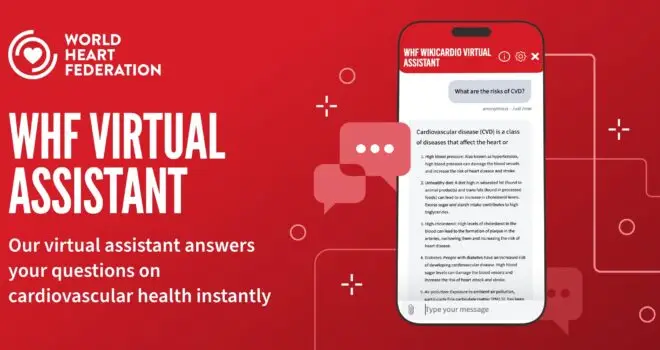COVID-19 has made everyone – even the most skeptical – realize how data, digital technology, and AI are true enablers for delivering health and care. Two new initiatives aim to use this momentum to help defeat the world’s biggest killer.
By Dr Ann Aerts, WHF President Prof Fausto J. Pinto, Elena Bonfiglioli
While cardiovascular, or CV, diseases have long been the leading cause of death globally, the COVID-19 pandemic has put a bright new light on the urgency to address them.
The global CV disease burden is worsening because by postponing regular health care visits during the pandemic, people are delaying the detection and management of CV risk factors such as high blood pressure, diabetes, and obesity. At the height of the crisis, over half — 53% — of the 155 countries surveyed by the World Health Organization reported partially or completely disrupted hypertension services, for example. This was also the case for 31% of cardiovascular emergencies.
This setback risks reversing the impressive advances in CV disease prevention and care in recent decades. While the full magnitude of these disruptions is yet to be seen, they have already led to increased acute CV events globally, which are responsible for the excess number of deaths that have been observed during the pandemic.
Yet, while the pandemic is having a devastating human impact, we can and must use it as a turning point in how health systems embrace digital, and use data and artificial intelligence in health.
In short, the pandemic has created a void in which other diseases are left potentially undiagnosed and untreated. This means we now face a syndemic – the convergence where an epidemic clusters and interacts with pre-existing conditions. The fact that people living with heart disease and its underlying CV risk factors have a higher risk of severe COVID-19 has made this convergence visible. But a syndemic is also driven by political, economic, and social factors, which is making its impact even more palpable in settings with existing health inequities.
Global collaboration around data is part of the solution for tackling CV disease.
The crisis has accelerated the realization of the potential of digital and data driven technologies in health, and provides an opportunity to truly reimagine the way CV health and care is delivered, from being reactive, to becoming proactive, predictive, and ultimately preventative.
New sensors, Internet of Things solutions, and remote monitoring technologies have emerged to help people self-screen for CV risk factors, accelerating detection, and empowering patients to take more responsibility for managing their own health. By placing a finger on a smartphone camera for instance, any person can transform the device into a blood pressure monitoring tool or an electrocardiogram recorder, which measures the electrical activity of the heart. A camera on a smartphone, laptop, or tablet can extract a person’s facial blood flow information to predict heart rate, blood pressure, stress and more.
Digital technology also allows us to deliver health and care closer to where people live, work, and play. The critical role of pharmacists in patient care, for example, has come to the fore during the COVID-19 crisis, when health facilities were overburdened. Connecting pharmacies on a common mobile platform has enabled them to be adequately trained in frontline management of CV risks and strengthened their participation in patient management.
In the long run, data generated by such technologies may deliver new insights for reducing the burden of CV disease. But as long as the data is hosted in separate systems, it can hardly be used for deeper analytics and machine learning models that provide new insights. This is unfortunate and still the case for much of the existing health data — the various types of siloed, noninteroperable electronic health records being just one example. This truly hinders the now urgent transformation of health and care delivery.
Two initiatives aim to remediate this: the World Heart Observatory that the World Heart Federation is creating with its member associations, and the Global Data Collaborative for CV Population Health, also known as AI4Better Hearts, which was launched last year by the Novartis Foundation and Microsoft.
Where the World Heart Observatory aims to become a one-stop hub for global data on CV disease, its biological risk factors, social determinants, and corresponding health system responses, the AI4BetterHearts Global Data Collaborative aspires to use AI and advanced analytics to combine, mine, and analyze CV data from different sources to better understand and address CV disease in large populations while upholding privacy standards.
Both initiatives align behind the same goal: improving CV population health enabled by data and AI driven approaches. Both initiatives will help achieve the United Nations’ Sustainable Development Goal 3.1 to reduce premature death from CV disease by one third by 2030.
COVID-19 has made everyone – even the most skeptical – realize how data, digital technology, and AI are true enablers for delivering health and care. We need to build on the momentum brought by this crisis to leverage their extraordinary power and transform CV population health. We are convinced there is no better opportunity to start curbing the syndemic and improve population health in an equitable way.


